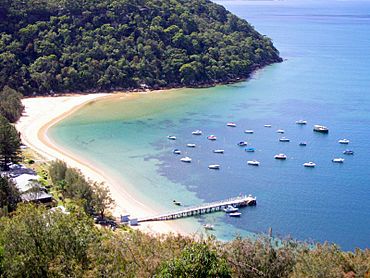Great Mackerel Beach facts for kids
Quick facts for kids Great Mackerel BeachSydney, New South Wales |
|||||||||||||||
|---|---|---|---|---|---|---|---|---|---|---|---|---|---|---|---|

Great Mackerel Beach, photographed from the south
|
|||||||||||||||
| Population | 50 (2021 census) | ||||||||||||||
| Postcode(s) | 2108 | ||||||||||||||
| Location | 43 km (27 mi) north of Sydney CBD | ||||||||||||||
| LGA(s) | Northern Beaches Council | ||||||||||||||
| State electorate(s) | Pittwater | ||||||||||||||
| Federal Division(s) | Mackellar | ||||||||||||||
|
|||||||||||||||
Great Mackerel Beach is a small, quiet suburb located about 43 kilometres north of Sydney in New South Wales, Australia. It's found on the western side of Pittwater, right inside the beautiful Ku-ring-gai Chase National Park.
This special place is next to Currawong Beach and close to Palm Beach. In 2021, only 50 people lived there permanently. However, many more people visit during holidays and weekends, as lots of houses are used as holiday homes. People often call it just "Mackerel Beach."
Contents
Geography
The Mackerel valley was created by a creek. This creek flows from inside the Ku-ring-gai Chase National Park. It passes through thick sub-tropical rainforest and mangrove trees. Finally, it reaches the north end of the beach, where it has formed a sandy area called a delta. The sand on the beach is soft and golden. It comes from sandstone that has traveled down the Hawkesbury River.
History
Mackerel Beach was first a dairy farm. A man named John Clark settled here in 1823. He later sold the land to Martin Burke, who is known as "The Father of Pittwater."
The land at Mackerel was divided into smaller plots in 1920. Since then, more than 100 houses have been built. At first, most of these houses were simple fibro shacks. They were used by fishermen or as weekend getaways. Over time, many changes have happened. Now, Mackerel Beach has all kinds of homes, from some of the original shacks to large waterfront mansions.
Housing
Great Mackerel Beach is often thought of as a place for holiday homes. However, it is becoming more like a regular beachside suburb. There are no shops in the area.
Getting to central Sydney from Mackerel Beach is an adventure! You first need to take a boat. This can be a private boat, a ferry, or a water taxi. After the boat trip, it's a 43-kilometre journey by road.
Facilities
The Northern Beaches Council says there are no public facilities at Mackerel Beach. However, homes do have electricity and telephone connections, which means Internet is available.
There is no public water supply or sewerage system. Instead, houses use water tanks to collect rainwater for all their needs. They also have septic tanks to deal with wastewater. Residents' rubbish is collected twice a week from special containers near the wharf.
Transport
Great Mackerel Beach is unique because it has no roads or cars! You can only get there by boat. This includes the Palm Beach Ferry, a water taxi, or your own private boat.
To get to Sydney, people usually take a short boat trip to Palm Beach. From Palm Beach, it's a 43-kilometre journey by car or bus. If you have a car, you can leave it parked near the ferry terminal at Palm Beach.
Public Facilities
There are no public facilities for visitors or residents at Great Mackerel Beach. This means you won't find public shops, toilets, barbecue areas, picnic spots, or drinking water. There is one public telephone booth near the wharf. Rubbish is collected for residents, but there are no public bins for visitors. You can find limited shopping options by taking a short boat ride to Palm Beach. More shops are available in the surrounding areas.
Recreational Boating
Many people who live at Mackerel Beach own boats. However, there are no public moorings available for boats visiting the area. This means you cannot tie up your boat at the Great Mackerel Beach Wharf. Private moorings are only for their owners and cannot be rented out or traded.
Community
Mackerel Beach Association
The Mackerel Beach Association (MBA) is a group of about 65 property owners. They represent the community, especially when dealing with the Northern Beaches Council. They work on important issues like parking, rubbish collection, and other matters that affect the people living there.
Pet Animals
Great Mackerel Beach is next to the Ku-ring-gai Chase National Park. Because of this, it is a Wildlife Protection Area (WPA). This means protecting the native animals is very important.
Historically, pet dogs were not allowed at Mackerel Beach. This rule is similar to other communities along the western shores of Pittwater. In 2009, the Pittwater Council decided to allow dogs off their leads in a specific area. This area is between the public wharf and the last house, near the National Park boundary. Dogs are allowed at certain times and with some rules.
Cats are not allowed in Wildlife Protection Areas like Mackerel Beach. The Pittwater Council banned pet cats because they can harm the native wildlife.

